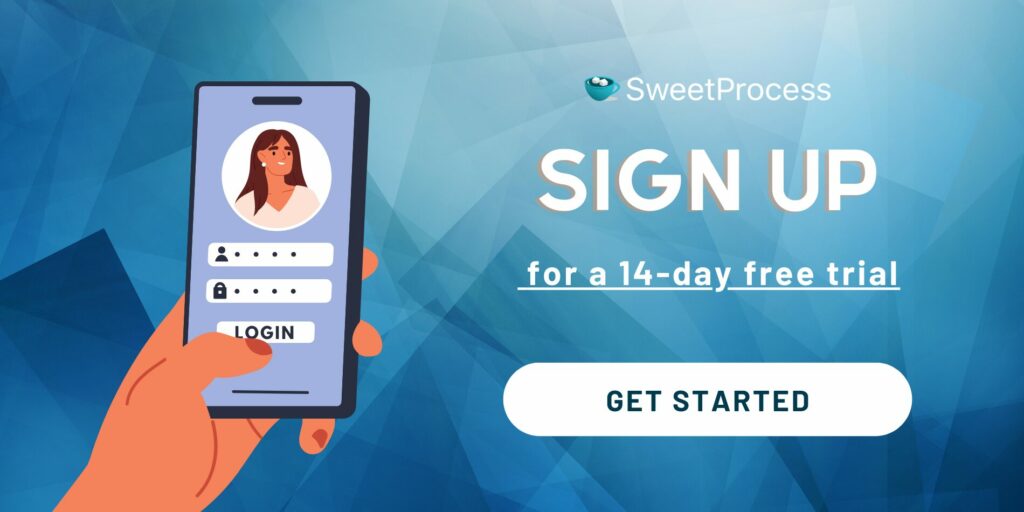Last Updated on November 22, 2025 by Owen McGab Enaohwo
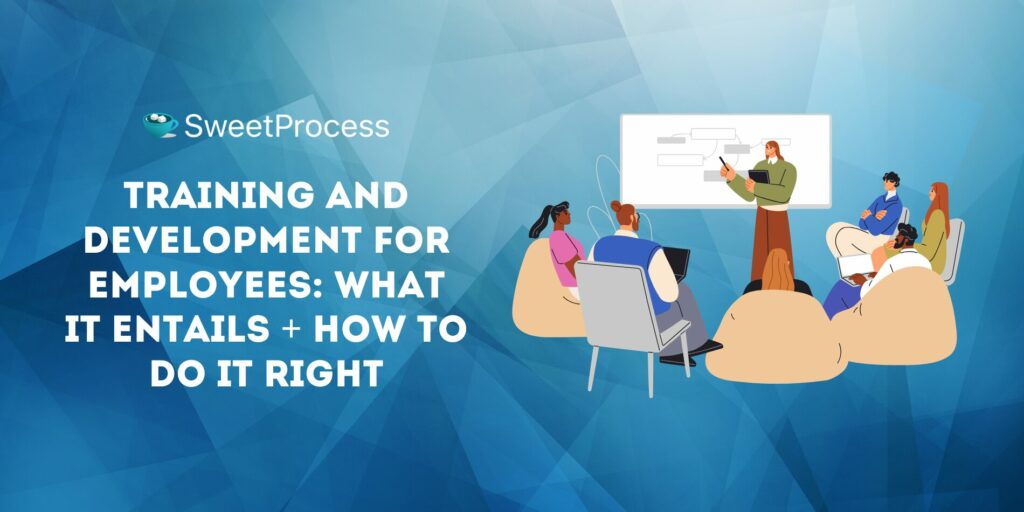
Effective employee learning and talent management goes beyond organizing free pizza Fridays and celebrating milestones. Businesses that aim to improve employee engagement and retain key personnel must equip them with essential skills to enhance productivity and prepare them to assume more advanced responsibilities.
According to Gallup, companies report a 21% increase in profit after engaging employees in training. When organizations invest in solid and organized training, employees are more likely to stay longer.
The result? A 24% increase in business profits, as a study from Zippia reported.
Helping employees develop practical skills to improve their professional experience is similar to working out at the gym. Just as existing muscles need exercise to grow and perform at their best, employees possess inherent abilities that can be sharpened through targeted training and development.
If you want to know what it takes to grow your employee’s muscle, this article is for you. We will explore several examples of development and employee training programs and also examine tools for effectively implementing them.
Start planning your employee training and development with SweetProcess for FREE!
Table of Contents
Training and Development: What It Entails
Why Employee Training and Development Is Important for Your Business
Types of Training and Development Programs
How To Manage Your Training and Development Programs With SweetProcess
How To Create a Winning Training and Development Strategy
Tools for Effective Training and Development
How To Measure the Effectiveness of Your Training and Development Programs
The Future of Training and Development
Transform Your Training and Development Programs Today With SweetProcess
Training and Development: What It Entails
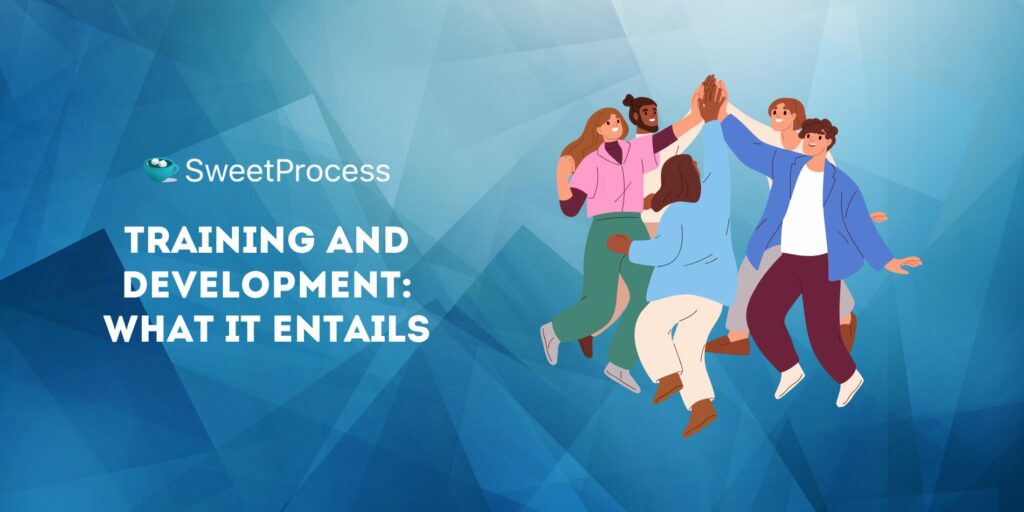
Companies achieve human resource goals by facilitating internal educational activities to groom new and existing workers. While training and development programs (T&D) typically go hand in hand, they are designed to achieve different results.
Training involves processes that enhance employees’ skills and proficiency, enabling them to perform better. This can be accomplished through methods such as training session, role-playing, or online courses. For instance, a newly hired front desk staff member at a luxury hotel requires technical training to carry out payment and billing procedures.
Development, on the other hand, is a system that inculcates valuable personal and career-driven skills and traits. Development programs in the workspace build on already existing skills to prepare a team member for more advanced roles or tasks in the long term.
Why Employee Training and Development Is Important for Your Business
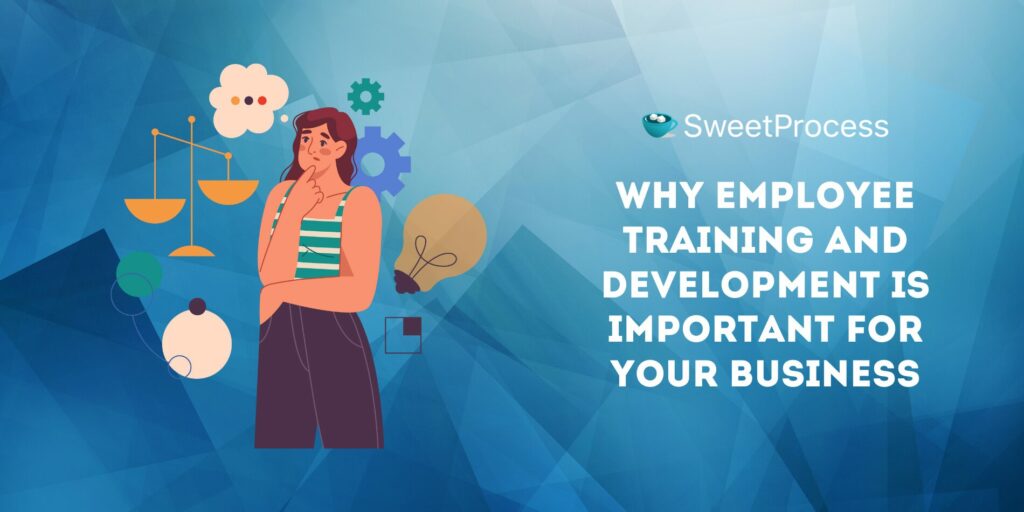
Employees excel at work when they consistently receive structured knowledge that enhances their skills, fosters a positive work attitude, and prepares them for more complex responsibilities. In turn, these benefits positively impact company-wide progress and improve overall efficiency.
Implementing employee training programs and employee development programs is critical for business owners. Below are a few outstanding reasons.
Enhanced Employee Performance and Productivity
When employees are uncertain about how to perform their role-related tasks efficiently, it inevitably impacts their productivity. Tasks take longer to complete, and delivery may not meet expectations. To address this, continuously engage your team with training and development courses and tools to help them improve their performance.
Training and development serve as morale boosters for workers. In fact, 59% of employees believe that employee training programs will help them perform at a better capacity.
Improved Retention and Engagement Metrics
Companies that implement adaptable T&D processes are generally better at retaining staff than those that do not. Because a learning culture in the workplace directly enhances employees’ skills, the desire to leave is reduced.
Businesses that implement training for their workers see retention rates increase by 30-50%. Therefore, they don’t need to constantly replace employees, which saves the company money and reduces the time spent onboarding and training session with new hires.
Accelerated Innovation and Adaptability
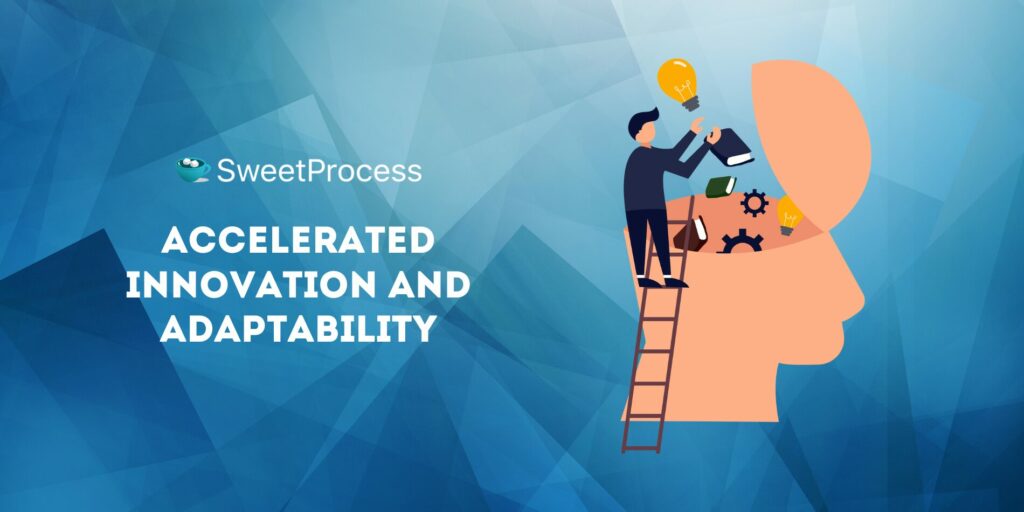
As tools and technology evolve, training will enable your hirelings to adapt quickly. Workers require these training programs to stay up-to-date with innovative and modern processes essential for effectively executing their roles. When you think of a tool to help you create an effective training management process, SweetProcess should be your go-to—empowering your business to accomplish more in less time while ensuring you stay ahead of the competition, as your employees already gain practical experience.
Risk Mitigation and Compliance Benefits
Your business can minimize the risk of compromise and exposure to critical company data and resources. For instance, training can help your IT staff become aware of hacks and breaches, enabling them to spot vulnerabilities and know how to handle them early.
Training is crucial for your business. It helps prevent fines and penalties by educating employees on recent compliance regulations. Data breaches in 2024 led to increased regulatory fines, with about 22.7% of organizations paying over $50,000 per incident. Therefore, training employees to identify and respond to potential violations is highly important.
Measurable ROI and Business Impact
Through training and professional development programs, companies can effectively track progress and assess the impact of recent changes on their organizational metrics and key performance indicators (KPIs). A practical training and professional development framework can reduce costs and minimize the time spent on routine tasks, thereby directly increasing revenue and advancing the company’s goals.
Types of Training and Development Programs
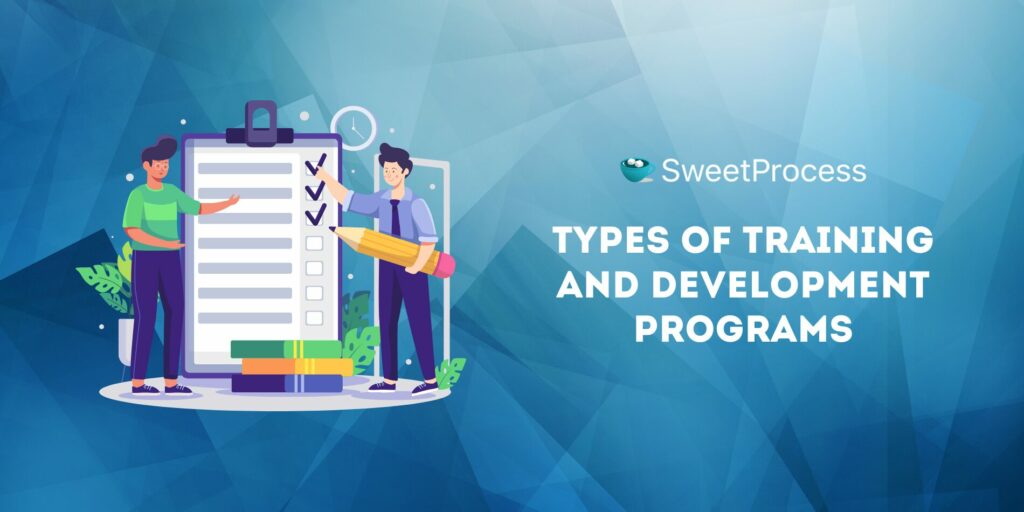
Deciding on the best training and development in HRM (Human Resource Management) relies on established objectives. Training activities can be implemented through various strategies tailored to align with an employee’s personality, job position, or industry practices.
Here are some of the most conventional yet effective techniques that successful companies use to train their employees.
Onboarding Programs
These activities are standard post-recruiting practices designed to help new hires adjust to their positions. Onboarding programs typically follow sequential processes and procedures that address crucial phases, including pre-boarding, orientation, training, and integration. Employers utilize methods such as onboarding calls, demos, and knowledge bases to ensure that new employees become well-acquainted with their roles.
Compliance and Policy Training
These trainings are vital for helping employees understand company policies, ethical standards, and industry regulations. This area is crucial for businesses since any oversight can lead to significant consequences that may harm a company’s reputation or result in substantial penalties. Compliance and policy training will help ensure that employees have a safe work environment while consistently upholding established quality standards.
Soft Skills and Communication Training
In addition to fulfilling standard job responsibilities, soft skills and communication training promote the development of interpersonal behaviors essential for a positive work environment. To foster appropriate attitudes among employees, business leaders must invest in educational initiatives that cultivate values aimed at enhancing communication, teamwork, problem-solving, and decision-making.
Technical or Job-Specific Training
Some roles within an organization demand specialized expertise. For example, marketing team members require training to become familiar with new advertising techniques. Job-specific training can be integrated during onboarding or periodically, particularly for positions that undergo rapid changes due to technological advancements.
Using an employee training program generator can simplify the process of designing and updating these specialized modules, ensuring employees stay aligned with the latest industry practices.
Leadership Development and Succession Planning
Business owners utilize this type of training to equip team members who have the potential to advance in their careers. Career growth expectations necessitate additional experience to ensure that newly promoted employees can quickly adapt to their new responsibilities. This type of training is progressive, as values are instilled through structured training programs, seminars, workshops, or even additional certification.
How To Manage Your Training and Development Programs With SweetProcess
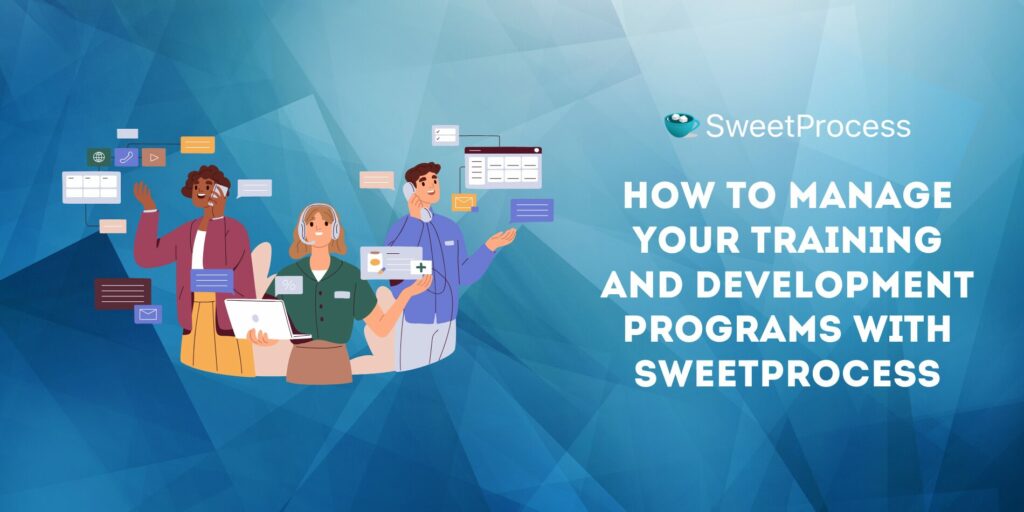
Creating training and development programs for your business might seem like a daunting task at first. However, don’t worry; with the right tools, you can design tailored activities efficiently and easily for your team.
We’ve added vital walk-throughs in the sections below to demonstrate how to build your ideal training and development courses with SweetProcess.
But you need to sign up first—don’t worry, you don’t need to pay for the first 14 days!
Document Your Company’s Procedures, Processes, and Policies
Effective training requires a structured format to ensure participants follow due processes in sequence. As a trainer, you can achieve this seamless framework by utilizing the appropriate training procedures, processes, and policies.
Documenting your training procedures, processes, and policies with SweetProcess will ensure that employees follow the established step-by-step patterns to learn new skill and implement them accordingly effectively.
Here’s how to set up procedures, processes, and policies with SweetProcess
1. Create a procedure for your business. Log in to SweetProcess, tap on More, and select Procedures.
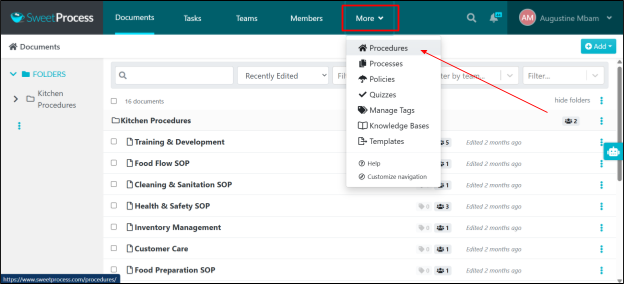
2. Tap on Create Procedure at the top right corner to start documenting steps.
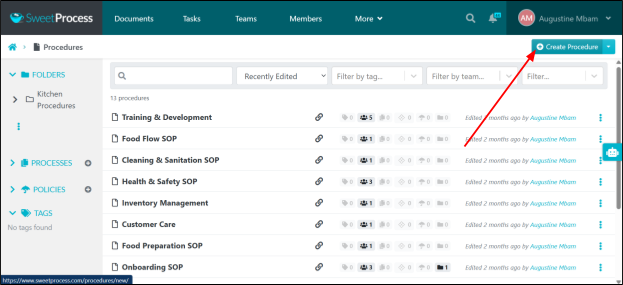
3. Type a title for your procedure and pick a team or teams to be in charge of it. If you need help writing your new procedure, click on Write with SweetAI or tap on Continue to write your procedures manually.
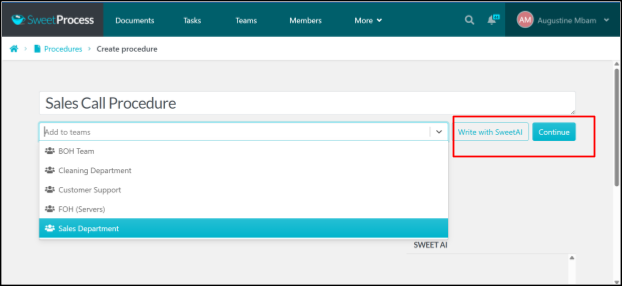
4. Review your procedures and incorporate interlinking lanes and steps. Make edits as needed. You can also include images, videos, links, and tables, and connect to any other procedure or process to ensure complete understanding.
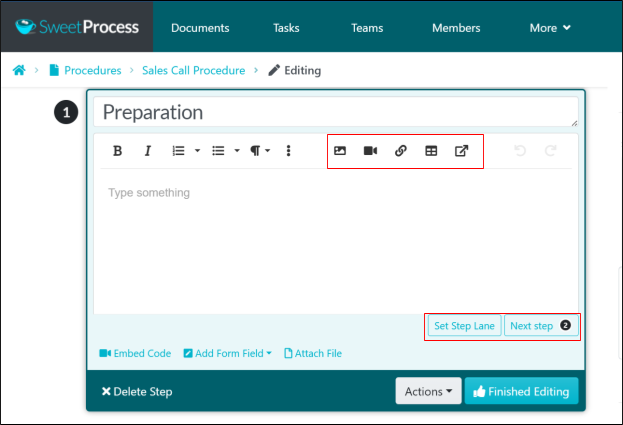
5. If you’re satisfied with your progress, click Approve to take your work live.
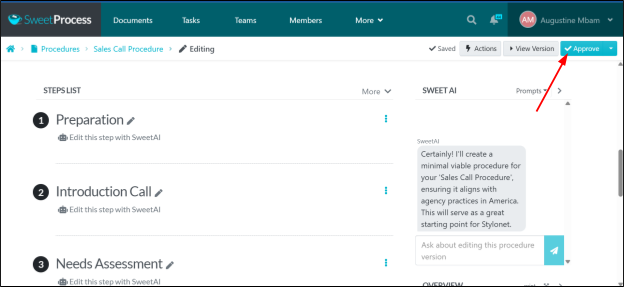
6. Set up new processes. Return to the main menu, click on More, and select Processes.
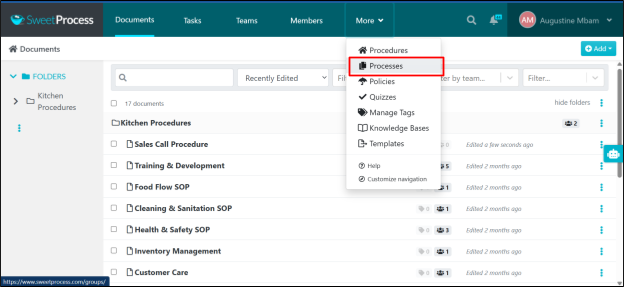
7. Tap on Create Process to start documenting details.
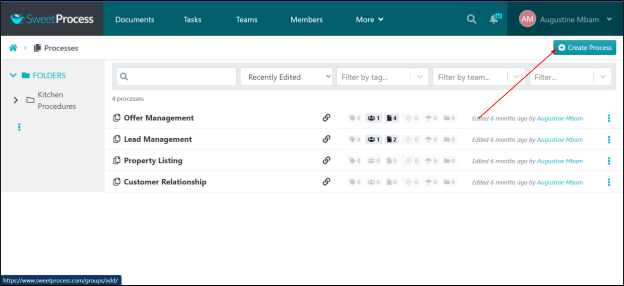
8. Pick a process title, select the designated team, and click Continue.
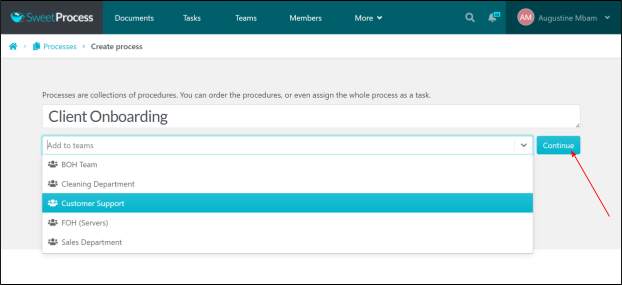
9. Add important texts, details, and resources to your process. Scroll down to the input steps. When finished, click on Approve to set it up.
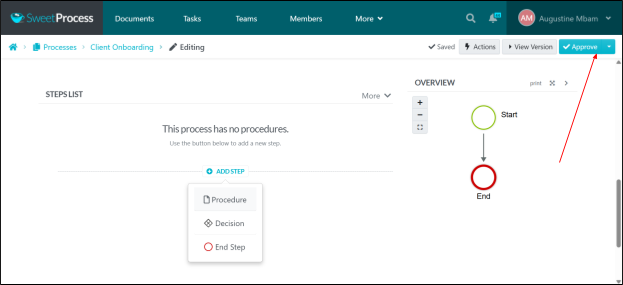
Repeat the above steps to create new policies whenever you need to. It’s super straightforward!
Create Training Materials for Your Employees
SweetProcess offers a wide range of features designed to help you create training resources, including knowledge bases, multimedia, flowcharts, and more.
A knowledge base is a valuable resource for trainees seeking clarification at any time. It can include FAQs, articles, and various materials to keep them informed without needing to contact colleagues.
Leveraging the functionalities of knowledge bases is a game changer for companies. pLink Leadership, an executive coaching and leadership development organization, supercharged their workflows and training programs when they began using SweetProcess’s knowledge base features.
Initially, this virtual company relied on a clunky Word document to store procedures and policies. However, this approach became problematic over time, as procedures quickly became outdated, making it difficult for employees to access them efficiently.
After signing up for a free trial of SweetProcess, Gretchen Pisano, the CEO of pLink, found that for the first time, she didn’t need piles of scattered files to onboard, train, and manage employees. pLink utilized SweetProcess’s knowledge base and procedure management features to train new employees, assign tasks, and improve their overall workflow.
Here’s how to create a knowledge base for your team on SweetProcess:
1. Just like setting up a new procedure, head to the main menu, tap on More, and pick Knowledge Bases.
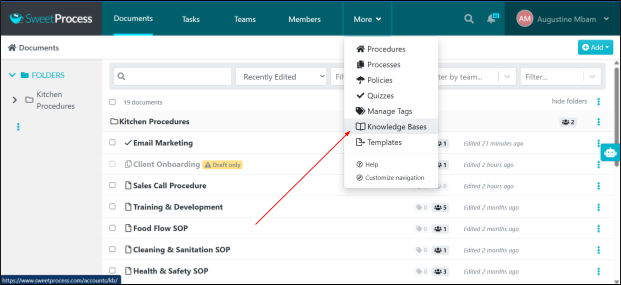
2. In the next interface, select Create Knowledge Base.
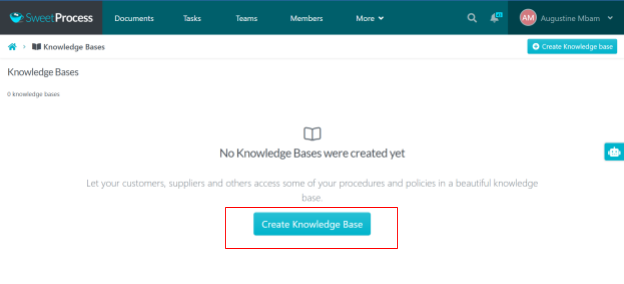
3. Enter a title for your new knowledge base, then click Continue.
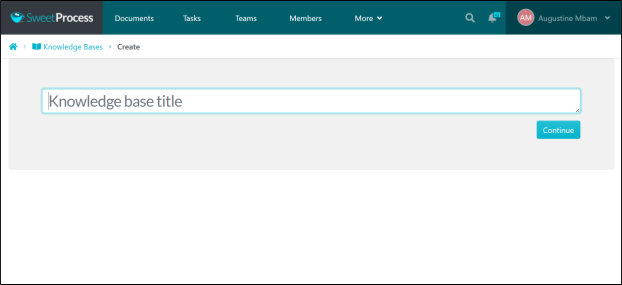
4. Next, choose a display theme for your knowledge base—perhaps something that aligns with your brand’s colors. You can also create new themes if you’re up for a bit of DIY.

5. Add a redirect link to route users to the domain for your knowledge base.

6. Edit text blocks to suit your business’s tone and style—reword placeholders, index headings, etc.
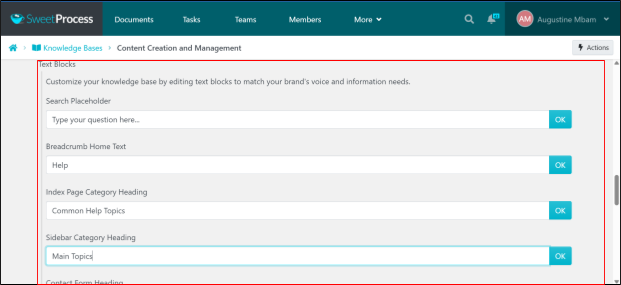
7. Add new categories for your knowledge base and select adaptable icons. When you’re all set, click Save Changes to save your progress and copy your knowledge base custom link.

Build a Quiz To Assess Your Team’s Grasp of the Training Materials
Quizzes are crucial in assessing how well employees have grasped new knowledge, new skill, or practices. Here’s how you can create and customize quizzes in SweetProcess.
1. In the main menu, click on More and choose Quizzes.
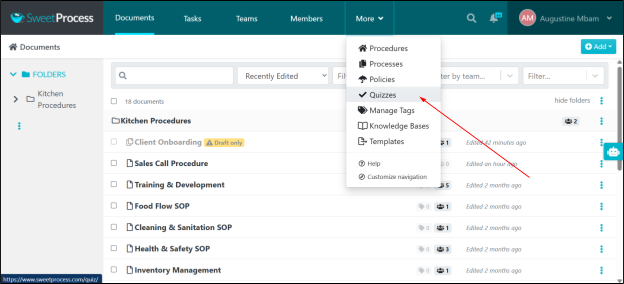
2. In the next interface, tap on Create a new quiz.
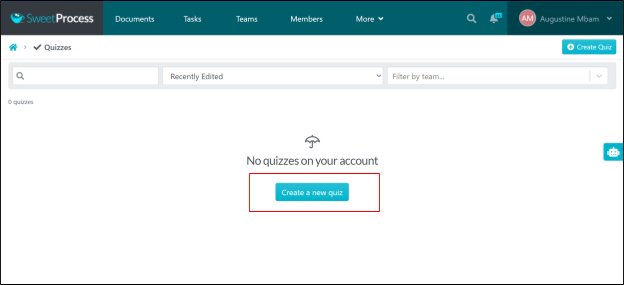
3. Enter a title for your quiz and select a team or teams you’d like to assign this quiz to and tap Continue.
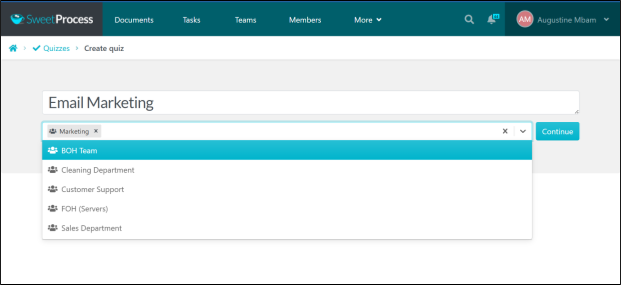
4. Enter essential details like an introduction or instructions for the quiz.
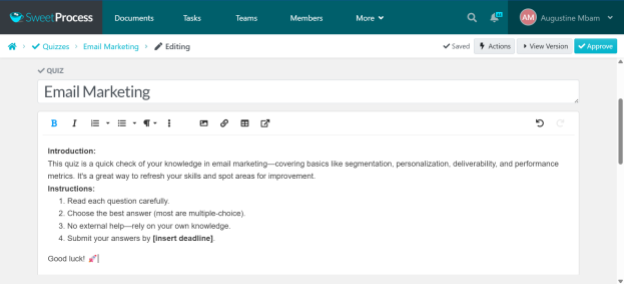
5. Select a duration for the quiz. You can pick an option from the list or create a custom duration. Also, choose a pass mark level for this quiz to set the difficulty.
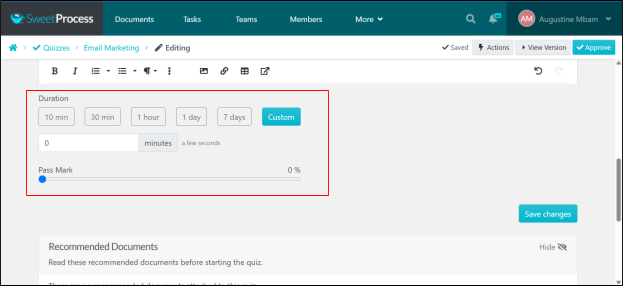
6. If needed, you can attach documents, such as procedures, processes, or folders that need to be incorporated into the quiz. Click on the appropriate document from the drop-down menu and then click the green check mark to add your document.

7. Next, you can begin adding questions for your quiz. You have the option to include multiple-choice questions or open-ended responses.
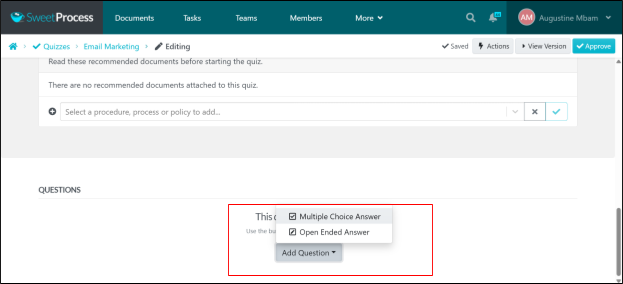
After setting your quiz questions, review everything to ensure there are no mistakes. If you’re happy with your work, you can approve the new quiz.
Assign the Training and Development Program as a Task to Key Stakeholders
Once you have set up your T&D programs, which include training procedures, quizzes, and processes, the next step is to assign them to stakeholders and managers for review, or to the appropriate members and teams for execution.
1. In the main menu, select a document (procedure, policy, quiz, etc.) that you want to assign to an individual or team. Tap on Actions to reveal a drop-down menu and select Assign as Task.
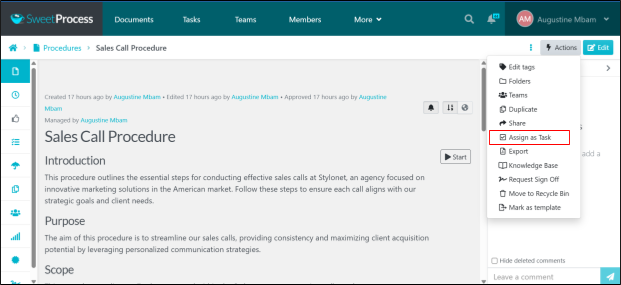
2. In the assignment box, choose whether you want to assign the document to an individual team member or several team members at once. To assign to an individual, select Teammates assigned their own task. After this, pick a teammate, a team, or invite a new member you wish to assign the task to, and click Next.
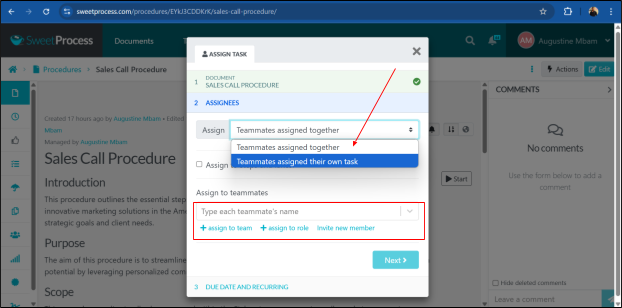
3. Create a schedule. Include deadlines, due dates, and recurrence periods if the task or exercise is meant to repeat, then click on Assign Task.
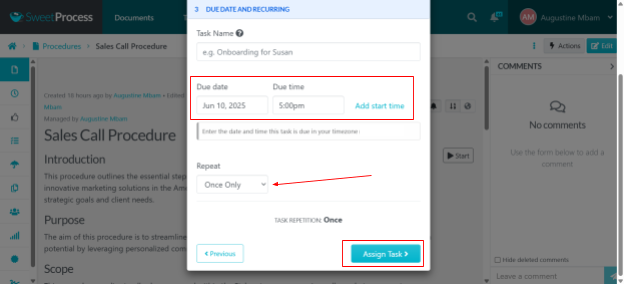
Set Up the Team To Reflect Your Company Culture
Intentionally setting up your team from the outset will establish the tone for your business’s progress and enhance your company culture as your team grows.
With SweetProcess, you’ll have the best companion to stay ahead of the competition and help your employees excel in their roles.
You can leverage SweetProcess’s team features to build and manage your superhero team effectively. Here’s how to create a team with SweetProcess.
1. In the main menu, navigate the top bar menu and click on Teams.
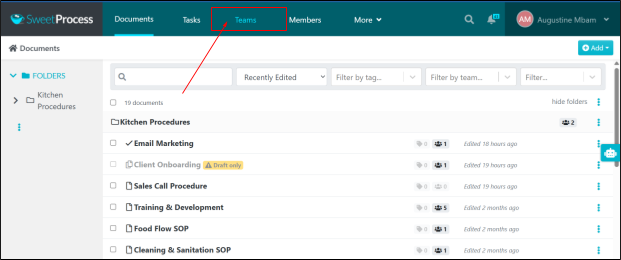
2. Navigate to the top right corner and tap on Create Team.

3. Enter a name for your team, e.g., Customer Support, and then write a description outlining the responsibilities of your new team. After this, click on Create Team.
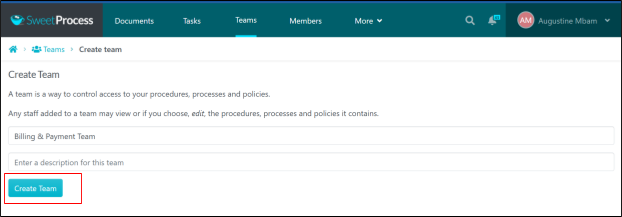
4. Create a role for your team. In the next interface, click on Create a role for this team. This will enable you to specify roles and responsibilities for team members.
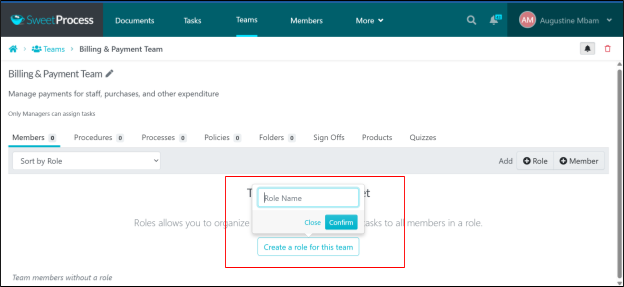
5. After mapping roles, click on Add members to this role, then select which employees are responsible for executing this role. Click Confirm after making your selection.
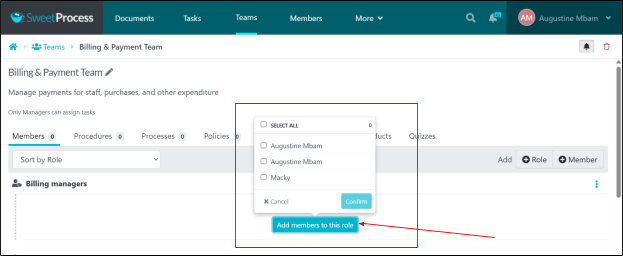
The Live Coach School, a B2C company offering coaching services and certification to clients, found itself trapped in a painful cycle where full-time employees left without passing on their knowledge to new hires. This made training tedious and employee development incredibly slow.
The game changer? Implementing SweetProcess turned everything around; employees now follow established processes for training programs, reviews have become swifter, and updates are now much easier to implement.
How To Create a Winning Training and Development Strategy
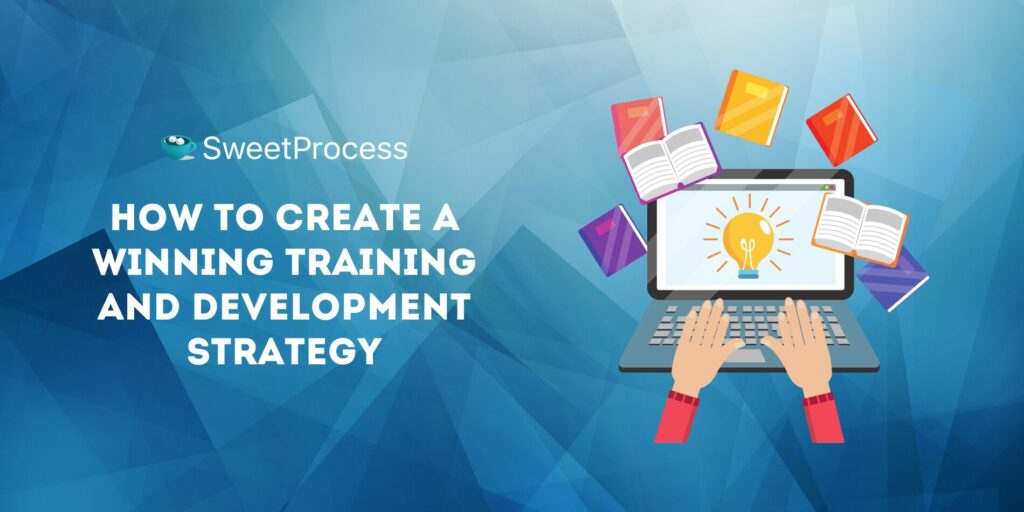
If you’re ready to implement a training and development policy for your business, it’s important to first create a solid and actionable framework.
Use this step-by-step guide to create a practical training and development strategy that fits your team and drives significant progress for your business.
Align With Business Objectives
Define the overall business goals and categorize them into segments. Do you want to boost revenue, improve quality, encourage compliance, or enhance customer retention? Consult stakeholders, departmental leaders, and experts about the objectives that need to be included for overall efficiency. Identifying what’s best for your business at a specific time will help you develop training activities that align accordingly.
Identify Skills Gap and Learning Needs
What in-demand skills do your employees lack? Identify the top skills that are crucial for departments and individual positions, and assess the level of experience your workers have with them. You can do this through surveys or one-on-one interviews. Once you have identified the skill gap, consult with subject matter experts to develop a curriculum to educate the relevant employees or teams.
Collaborate With Departmental Leaders
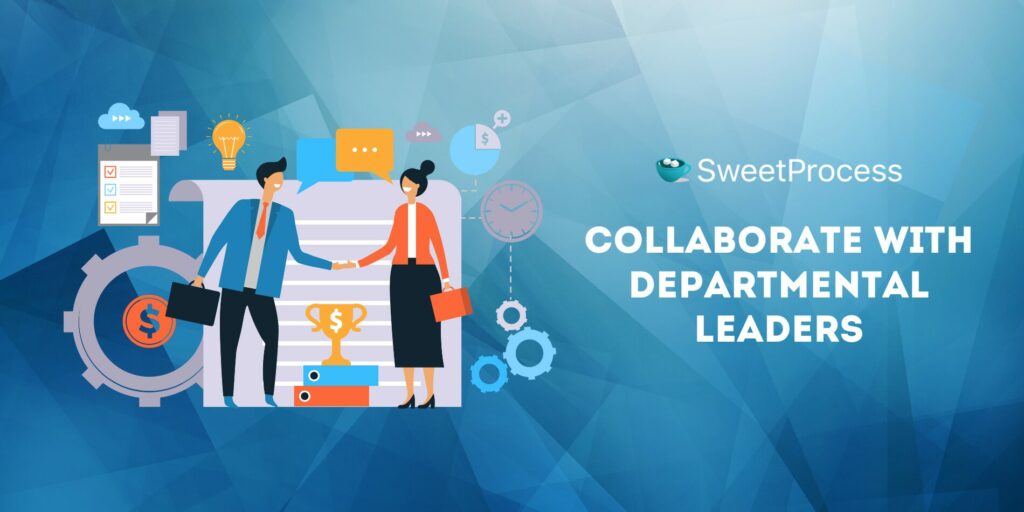
Departmental leaders are primarily subject matter experts and are also in the best position to inform and advise you on areas that need attention. Encourage them to propose the best training needs, practices, and involve them in critiquing your training strategy before its implementation.
Select the Right Tools and Platforms
Training requires several resources—research practical tools, software, and programs that will facilitate achieving your business objectives. For instance, you may consider integrating artificial intelligence tools to enhance efficiency for specific procedures. Ensure that these tools and platforms are accessible to the right teammates and create a training program to teach them how to use them effectively.
Deliver and Track Training Effectively
Timing is crucial. Ensure that your training needs cover every critical area. Use demos, role-playing, and test tasks to track assimilation and encourage engagement. Additionally, integrating checklists and encouraging teammates to find accountability partners will allow for effective tracking. Set training program deadlines to ensure that employees’ skills have improved adequately.
Evaluate Success and Iterate
Deploy your training strategy. Provide opportunities for feedback and monitor progress critically, ensuring that the expected improvements are occurring. Of course, progress won’t be instant. Employees will need time to become thoroughly acquainted with new or improved procedures. Ensure that they receive sufficient support from experts if necessary. Once your strategy shows good progress, you can iterate and implement it in other areas.
Tools for Effective Training and Development
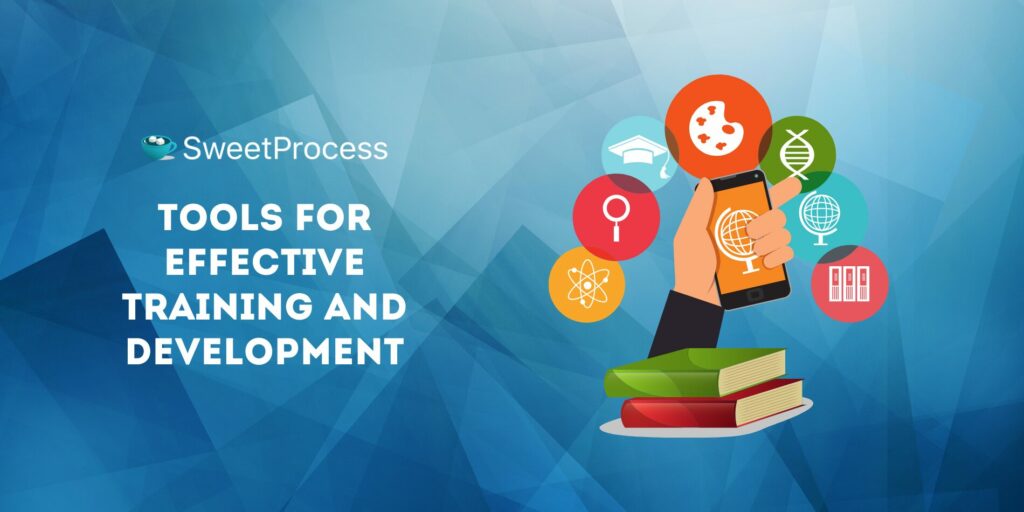
As more organizations adopt and integrate technology into every aspect of their operations, extending these interactions to training programs is sensible.
Specific tools should be employed to help employees quickly assimilate new practices, methods, and procedures. These tools are not only efficient for facilitating T&D programs but also adaptable. Here are some recommendations.
Learning Management Systems (LMS)
Imagine the hassle of keeping up with hundreds of procedures scattered in different folders across various platforms. Learning management system (LMS) are the solution to organizational chaos. They are a central hub for accessing training resources, including videos, checklists, and documents. They include personable learning features, so that employees can learn on the go.
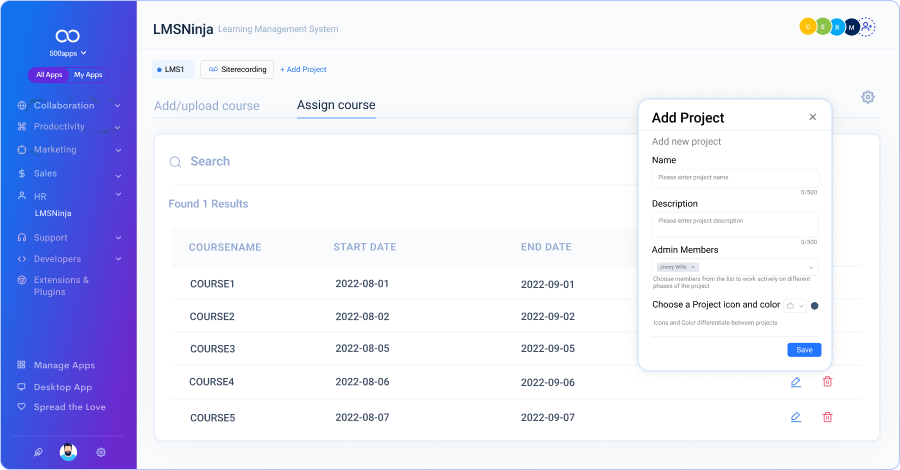
Source: LMSNinja
Why Learning Management Systems Work
- Knowledge base: They enable the safe storage of relevant files and resources crucial for executing specific tasks.
- Intuitive and customizable: LMS platforms are designed to be user-friendly, ensuring that no employee is left in the dark. Users and tutors customize the learning process and ensure that the appropriate permissions are granted to the relevant parties.
- Cost-effective: LMS platforms serve as an all-in-one solution that facilitates efficient file sharing, enhances team communication, and promotes adaptable learning experiences. These features can be obtained without breaking the bank, thus reducing operational costs in critical areas.
eLearning Authoring Tools
eLearning authoring tools are special software capable of authoring learning content (creating, editing, and designing). These tools enable trainers to introduce advanced content resources, such as animations, quizzes, flowcharts, and even simulations, to stimulate a more effective learning experience.
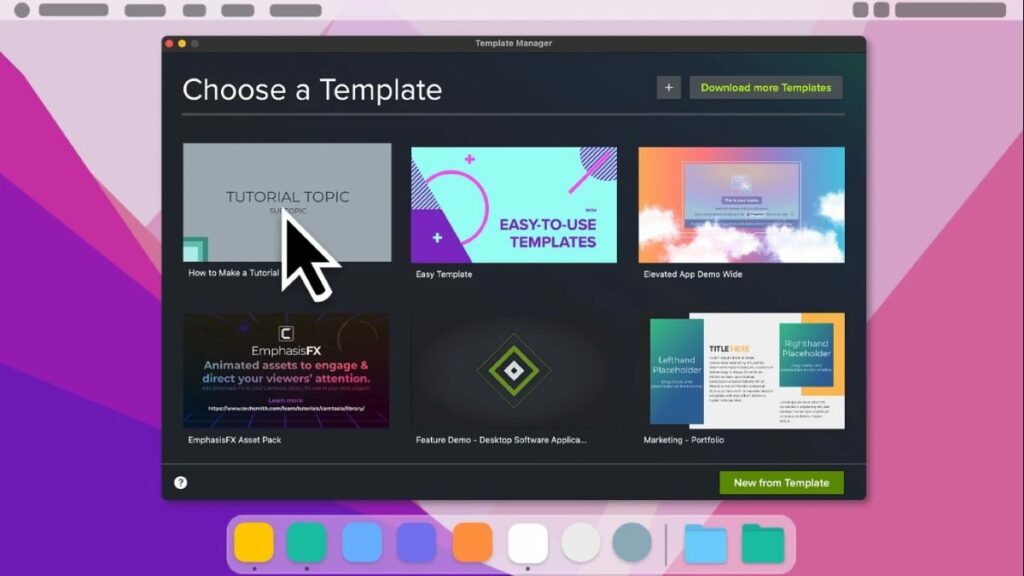
Source: eltchalkboard/Camtasia
Why eLearning Authoring Tools Work
- Advanced learning experience: No need for dull texts. An effective eLearning authoring tool offers features that present tutorials and learning materials in engaging formats that promote learning.
- Easy-to-Update: Available features ensure trainers and stakeholders can make changes to already-existing resources, which is reflected almost instantly to all relevant users. Also, custom templates and simple drag-and-drop features make it easy to roll out new learning materials.
Performance Management Systems
These are tools that specifically allow managers and team leads to observe, evaluate, and improve employees’ performance. Enabling these features in training and development practices will ensure that stakeholders can track their employees’ progress and provide support if necessary.
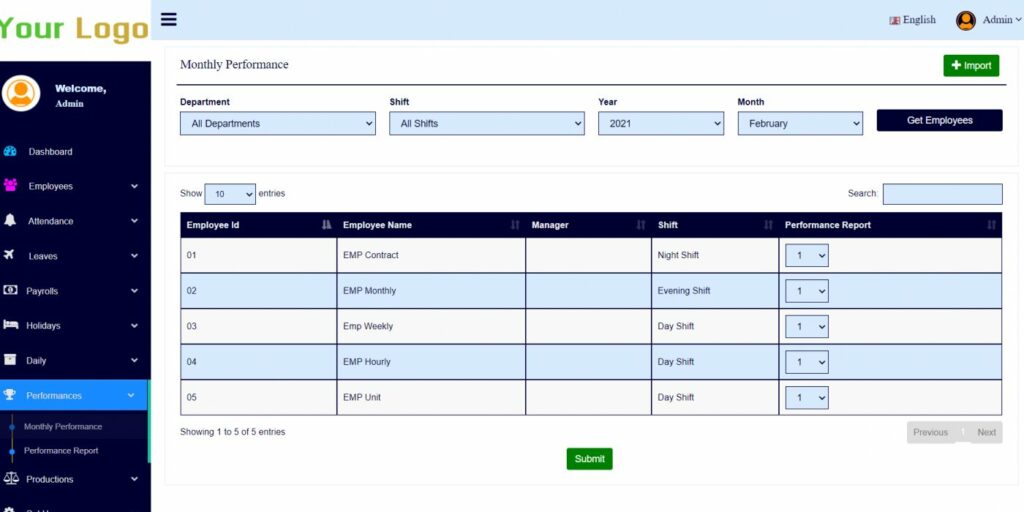
Source: Phphr.com
Why Performance Management Systems Work
- Link training programs: Performance management systems can be integrated into training programs to provide a tailored learning experience for individual employees.
- Identify specific skill gap: Implementing performance management systems will help managers effectively assess their employees and spot areas for improvement.
- Career growth and recognition: When team members complete milestones and full programs, their profiles can receive updated badges or incentives to acknowledge their progress and demonstrate that they are ready to take the next steps in their careers.
Collaboration and Communication
Collaboration and communication tools include platforms and systems that foster seamless workplace interaction and on-demand information delivery. These tools are essential for employee training and development as they are designed to enable real-time collaboration between employees and managers.
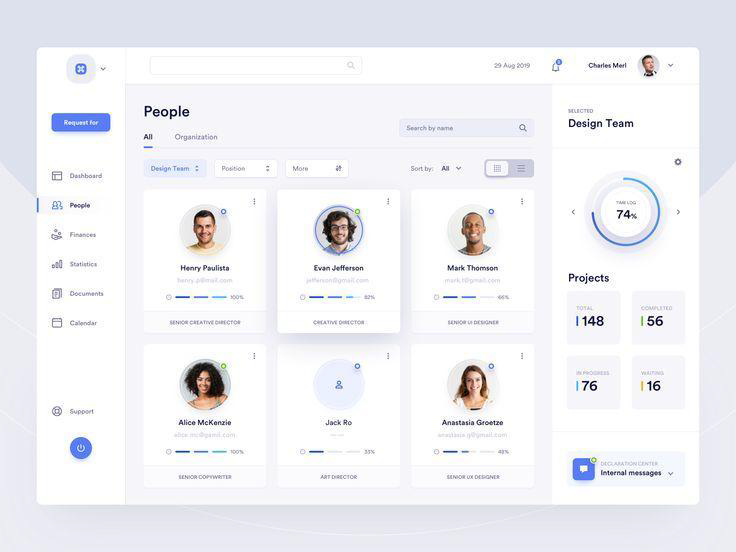
Source: Karol Kos/Pinterest
Why Collaboration and Communication Tools Work
- Interactive system: Employees can stay engaged with live chat rooms, polls, and virtual conferences, allowing them to stay connected to work on the go without missing crucial updates.
- Support for hybrid and remote staff: Employees who are not physically present can still keep in touch with onsite workers. This will enable seamless task and information delivery at all times, regardless of anyone’s location.
Analytics and Reporting
These are tools that interpret, compile, and present data-backed reports about employee performance and overall organizational objectives. These reports include metrics that showcase whether training objectives are met and whether trainees are keeping up with updates within learning management system.
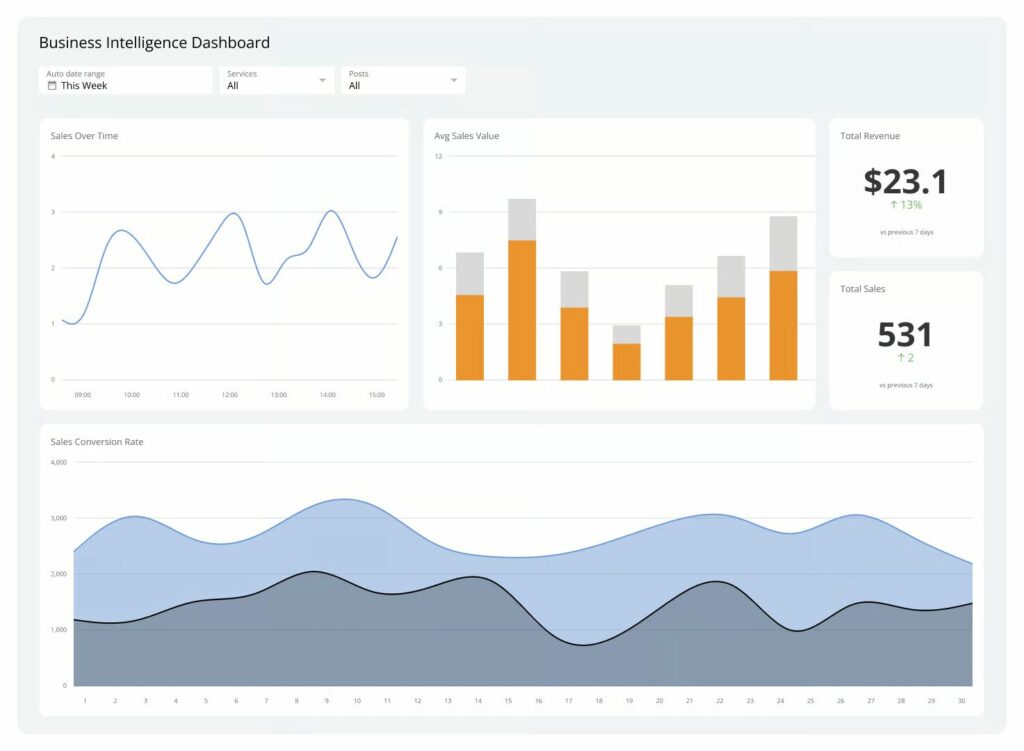
Source: Klipfolio
Why Analytics and Reporting Tools Work
- Track progress and KPIs: Gather data-driven metrics on the impact of training programs. If progress is slow or delayed, stakeholders can implement integrations to ensure that changes are made.
- Improve decision-making: Analyze dashboards and graphs to discover emerging trends in your industry or internal changes. These infographics provide stakeholders with an opportunity to identify patterns and leverage that information to implement improvements.
How To Measure the Effectiveness of Your Training and Development Programs

The primary objective of implementing training and development programs is to enhance efficiency in key areas of a business. Whether the aim is to increase revenue, reduce costs, or enhance quality, assessing the effectiveness of training activities is crucial. This evaluation will help determine if your training strategies are successful or if adjustments are needed.
If your team relies on digital training tools, using a learning management system for small businesses can make this process even more precise.
Here are several common techniques to evaluate the progressiveness of your training and development policy.
Learning Outcomes and Skill Growth
Develop a clear statement or framework regarding the competencies employees must possess after completing specific training programs. For instance, a cybersecurity intern must understand how to detect and report insider threats following a ransomware attack training.
Managers can set up pre- and post-training quizzes to determine the effectiveness of the training programs and offer certification if the results are satisfactory.
Business KPIs and Productivity Gains
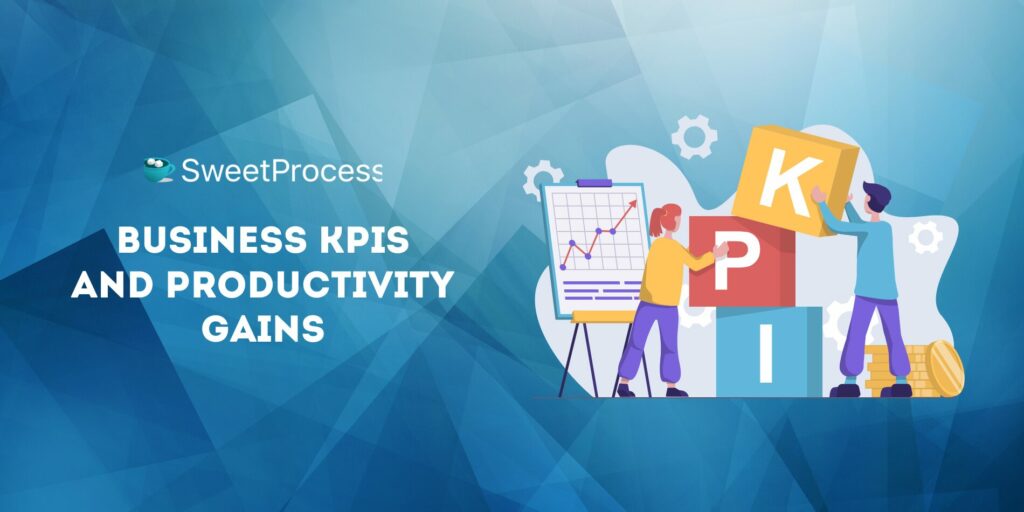
Monitor improvements in key performance metrics. Positive changes in revenue, team collaboration, and time management are some important indicators to look out for.
Check if:
- Employees completed their training
- Employees have developed competencies in relevant skills
- KPIs tied to certain training activities have seen positive growth over week, month, or quarterly periods
Employee Feedback and Engagement Scores
Be receptive to feedback from both employees who have undertaken the program and managers. Ensure that milestone evaluations are incorporated at crucial stages to confirm that trainees have effectively engaged with the programs and are now proficient in new or enhanced tasks.
Use:
- Checklists to confirm that training steps and procedures are followed accordingly
- Badges, milestones, and certification to acknowledge the completion of stages
- Q&A to verify proficiency and encourage feedback
ROI and 5-Level Evaluation Models
Determine the monetary benefits of already established training programs using the Philips ROI Model. The data from this finding will show how training impacts your organizational ROI (Return on Investment). This method includes five steps.
- Reaction: Use surveys to evaluate the reactions of trainees toward their educational programs
- Learning: Make participants undertake pre- and post-training quizzes to ascertain how well they have learned.
- Application: Beyond gathering data, test participants in real-world scenarios to display how they can implement their new knowledge. Gather feedback from these exercises and improve training programs.
- Results: Examine the impact of training on targeted business objectives. Use metrics to calculate productivity, efficiency, and customer satisfaction.
- ROI: Evaluate financial return after training. Compare the costs of implementing training and current quantifiable results, like revenue increase and cost minimization.
The Future of Training and Development
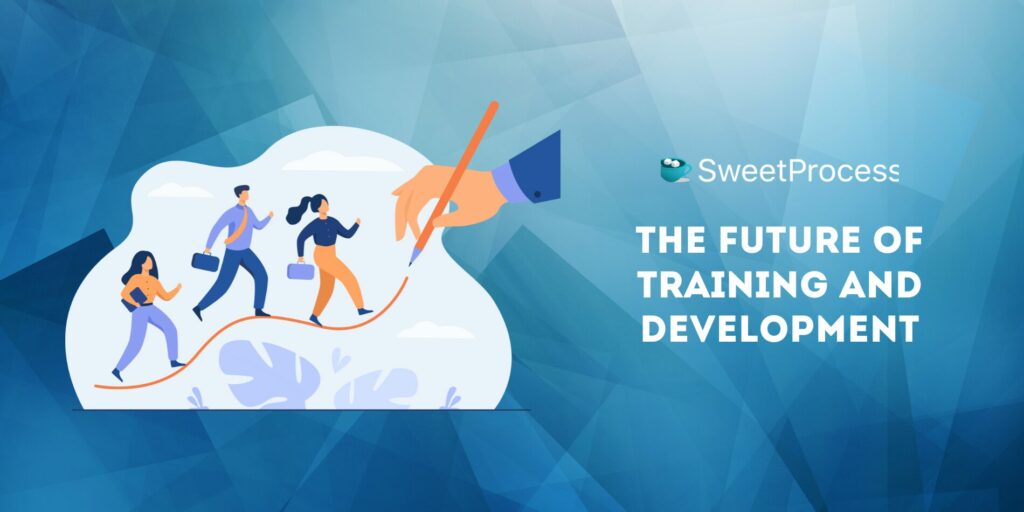
Emerging technologies are rapidly transforming traditional practices in various industries, as well as in our homes and personal lives. Therefore, to keep your business competitive, it is essential to recognize upcoming trends and apply them for training and development in your workplace.
AI-Powered Learning Paths
When you think of AI, you think of scalability and adaptability. Artificial intelligence utilizes machine learning to predict learning patterns. In the future, AI’s dynamic ability to analyze and scale data will be used effectively to understand your employees’ strengths, identify specific skill gap, and even recommend suitable training programs with adjustable difficulty.
Immersive Experiences via AR/VR
Augmented Reality (AR) and Virtual Reality (VR) will provide highly engaging and realistic learning experiences in the near future. While this is already possible, significant improvements are anticipated. For instance, trainers will be able to customize high-stakes skills gap like surgical procedures, allowing participants to test their skills without real-world implications, thereby minimizing costs. Additionally, 3D simulations can be used to assess whether trainees are prepared for realistic scenarios by evaluating their reactions and decision-making skills.
Personalized Career Development

By leveraging data and a clear understanding of individual aspirations and skills, tailored training appropriate for specific team members can be developed. Instead of generic learning methods, employees can learn at their own pace. For example, in this scenario, upskilling for a promotion will involve employee-centric training options that support diverse career goals.
Social and Collaborative Learning
Employees will have access to accelerated communication tools for peer-based learning and mentorship. Real-time collaboration during learning will allow workers to interact with their team members, obtain support, and practice skills. These features will be further integrated into daily tools, allowing team members to stay up to speed with one another and remain motivated to learn.
User-Generated Content
User-generated content (UGC) are direct and practical ways for employees and seasoned professionals to share their expertise in areas where they excel. Individual members can offer how-to videos, case studies, and tips for navigating complex procedures in real time when necessary. This not only keeps them engaged but also boosts their motivation and willingness to support their teammates.
Gamification
Points, badges, leaderboards, and duels are examples of gamified incentives that can make learning more creative and interactive. By engaging in fun learning methods, individual employees can reinforce their learning and improve retention. Teams can also be motivated to approach their work more creatively with increased motivation. For instance, the sales team might be driven to score more points than the customer service teams and earn specific incentives. Gamification for training and development will also promote teamwork and help employees cultivate leadership skills.
Transform Your Training and Development Programs Today With SweetProcess
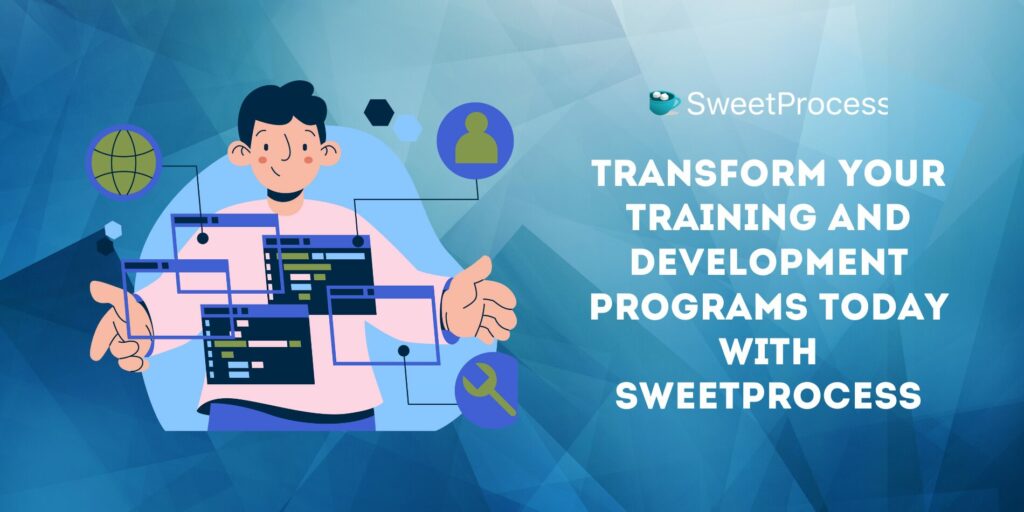
Demystify the process of setting up training and development programs for your organization. With SweetProcess, developing T&D programs is simpler than ever. With a suite of features that promote intuitive learning, collaboration, and team management, your team won’t be left in the dark.
SweetProcess is adept at enabling employees to learn at their own pace while allowing managers to supervise and evaluate their progress. What’s more, everyone on your team can access central knowledge bases to find specific training information at any time.
Centralize your T&D processes with SweetProcess. Try it FREE for 14 days for everyone on your team!
